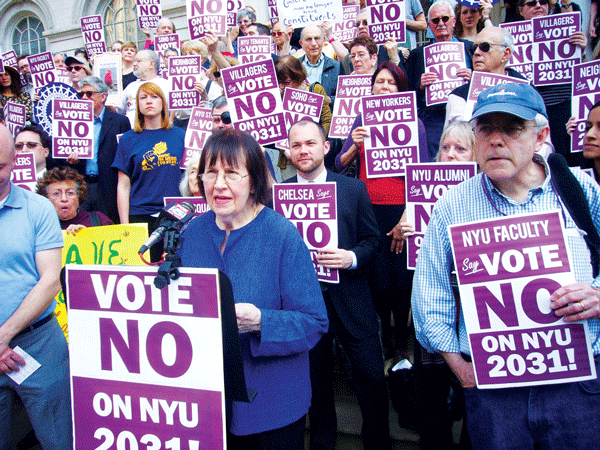 [/media-credit]
[/media-credit]
The March 22 rally, organized by the Greenwich Village Society for Historic Preservation, included preservationists, N.Y.U. faculty and students, union organizers and residents of the Village, Soho and Chelsea.
The proposal to add 2.5 million square feet of development in the coming 20 years to the superblocks between LaGuardia Place and Mercer St. from Houston to W. Third Sts. is in the midst of the city’s uniform land use review procedure (ULURP).
The six-to-nine-month review, which involves hearings by Community Board 2, the Department of City Planning and a final decision by the City Council, must also include a recommendation by the Manhattan borough president.
Demonstrators shouted their demands directly to Stringer as he passed through the City Hall plaza on his way to his office in the Municipal Building at the end of the rally last week.
“We have to be able to expand universities without overwhelming communities,” Stringer replied.
The borough president will make his recommendation to City Planning on April 12. City Planning has 60 days from then to act, and the Council has another 50 days, with a possible 15-day extension, for a final vote.
While the borough president is not required to hold a public hearing, Andrew Berman, G.V.S.H.P. executive director, told the rally last week that Stringer could choose to hold one.
Berman told the rally that he delivered more than 2,500 petition signatures urging Stringer to reject the plan that would add the equivalent of the Empire State Building’s square footage to the two superblocks.
“This expansion would be a disaster for the university, Greenwich Village and for the city,” Berman said.
Patrick Deer, an N.Y.U. tenured professor of English agreed.
“The Sexton plan would endanger the Village and the university,” Deer said, referring to N.Y.U. President John Sexton. “It could easily bankrupt N.Y.U. and keep potential faculty away. No one will want to live on a construction site for 20 years,” he added.
Deer went on to say that a faculty poll on whether to back a compromise plan for the superblocks was “a unanimous and uncompromising ‘No’.”
Peter Rea, associate professor at the N.Y.U. Tisch School and a resident of Silver Towers on the south superblock, was also concerned about living in a construction zone for 20 years. Rea charged that the expansion would “turn the Village into Midtown Manhattan.”
Democratic District Leader Jenifer Rajkumar told the rally that Stringer had to “decide whether to give in to greed or stand up with us and do what is right, not what is easy.” She charged the university wants to “strip away years of zoning that protected Greenwich Village from exactly the kind of development that N.Y.U. is proposing now.”
Scott Sommer, a United Auto Workers union official seeking N.Y.U. recognition for unionized graduate student instructors, questioned the funding for the expansion.
“We are concerned that it will be built on the economic backs of N.Y.U. faculty, students and workers,” he said.
Simeon Bankoff, executive director of the Historic Districts Council, said that plans to change zoning and cancel deed restrictions that were imposed when the superblocks were created during the Robert Moses era would lift longstanding neighborhood protections and open-space requirements.
The preservationist noted that the three high-rise I.M. Pei-designed buildings on the south superblock are designated city landmarks. Although this landmarked complex is just outside the proposed development site, high-rise construction on the superblocks would decrease the landmarks’ architectural impact and make them “just another bunch of tall buildings,” Bankoff said.
Anne Hearn, co-president of the Washington Square Village Tenants Association on the north superblock, said that if the plan were approved, “a baby born now would spend the first 20 years of his life in a construction zone.” The university has other expansion options — in Lower Manhattan and Brooklyn — Hearn said. “We have none,” she said.
Also giving remarks were Corey Johnson, chairperson of Community Board 4, who spoke as a member of the Council of Chelsea Block Associations, and Lesley Doyel, co-president of Save Chelsea. They said that removing zoning protections in the Village superblocks would set a precedent that would threaten Chelsea to the north.
Dave Keerl, speaking for the Soho Alliance, Edith Charlton, a member of the Union Square Community Coalition, and Georgette Fleischer, a founder of the Friends of Petrosino Square in Little Italy, also said the N.Y.U. redevelopment would have a negative impact on their neighborhoods.
A Stringer spokesperson two weeks ago told this newspaper that Stringer did not intend to hold a hearing on the N.Y.U. plan. She noted that C.B. 2 recently held 16 public hearings on the plan, plus the Borough President’s Task Force on N.Y.U. Development previously held more than 50 meetings on it, so the mega-project has received a thorough public review and comment.
The spokesperson said that Stringer, instead, was “meeting with community members — stakeholders and community leaders — on an individual basis.”

















